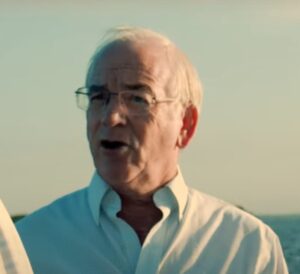The retiring director of the Sarasota Bay Estuary Program talks about resilience.
By Noah Vinsky
Original Air Date: January 1, 2025
Johannes Werner: How does a warming climate change the balance of water? Noah Vinsky talked to Dave Tomasko, the biologist and retiring director of the Sarasota Bay Estuary Program. Tomasko has been quite vocal on this topic recently, and he won’t disappoint you.

Map of Sarasota Bay
Noah Vinsky: Dave Tomasko is the retiring director of the Sarasota Bay Estuary Program, an organization that partners across the community to improve the health of Sarasota Bay. Tomasko is an expert in water quality science and has over 30 years of experience in the field.
Every five years, the Sarasota Bay Estuary Program releases a long-range habitat restoration plan to identify restoration projects in the bay. Local, state and federal sources have been pouring money into ensuring water quality. Nearly $1 billion will be spent on restoring Sarasota Bay, which Tomasko says has resulted in the best water quality the Bay has seen in over a decade.
Dave Tomasko: And because of that, I think we’re better able to handle the kind of conditions that we experienced in 2024, with all the rainfall and all the other impacts. There are things we can act on, that we need to act on, and because we are acting on them, it’s going to be good for the health of Sarasota Bay when we don’t have a Red Tide, when we don’t have a hurricane. But when we do have a Red Tide, when we do have a hurricane, it’s going to be even more important, because we’re a more resilient system than we were a couple of years ago.
NV: 2024 was a particularly intense year for flooding in Southwest Florida. Sarasota and Bradenton saw the wettest summer on record, according to the National Weather Service, receiving over 47 inches of rainfall this summer, crushing the season average of 23 inches. Three major storm systems rocked the area with hurricanes Debby, Helene and Milton, bringing storm surge, torrential rain and winds over 100 miles per hour. Will climate change make years like 2024 more common? Tomasko thinks so.
DT: You know, the kind of flooding that we had with that rain event in June, the kind of flooding we had with Debby, the flooding that happened to the north of us, mostly with Milton, that’s the kind of weather systems that are going to be more common the next couple of decades than the last couple of decades, because our air is warmer, our water is warmer, and we’re adding more fuel to these tropical weather events. So I don’t think there’s a consensus that we’re making more hurricanes, but there is a consensus that we’re making hurricanes more powerful.
NV: Tomasko says that current stormwater regulations are based on an expectation of rainfall that may not be accurate anymore, making it difficult to handle increased rain events.

Dave Tomasko
DT: For example, most of our stormwater rules and regulations are that you have to handle, like one in 100-year, 24-hour rain event, and that is 10 inches of rain, roughly. So I build a stormwater treatment system, I build my neighborhood to be able to handle 10 inches rain in 24 hours. How many times have we seen the 10 inches in 24 hours? I mean, several times. So I’ve lived through several 100-year rain events in the last, say, 20 years. So I think one of the things that we need to think about is, are our stormwater rules and regulations no longer accurate for the types of weather we seem to be getting recently?
NV: He also says that old wastewater collection systems are leading to increased overflows. The City of Bradenton has repaired nearly half of the 62 mile-long clay sewage pipe system that is a century old. Tomasko says that the city needs $22 million to fix the remainder of its wastewater system.
DT: We need to harden our wastewater infrastructure. And what that means is not just necessarily building new wastewater treatment plants, but lining the pipes that bring the wastewater to our stormwater treatment plants or wastewater treatment plants. So for example, the City of Bradenton had lots of overflows this year, mostly because a lot of the collection system, the pipes that take your wastewater from your house to the lift station, those are like clay pipes. And when the water level is high in the ground, water leaks in. And the reason why we had so many discharges from the City of Bradenton, frankly, was because we had a system that was stressed by too much water coming into it. And that too much water coming into it was because the collection system was too leaky. Infiltration and inflow from aging infrastructure, like 70-50 year-old wastewater collection pipes, is stressing our wastewater system.
NV: This has been Noah Vinsky for WSLR News.
WSLR News aims to keep the local community informed with our 1/2 hour local news show, quarterly newspaper and social media feeds. The local news broadcast airs on Wednesdays and Fridays at 6pm.